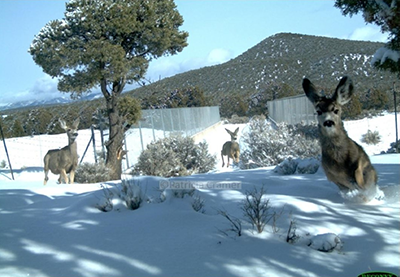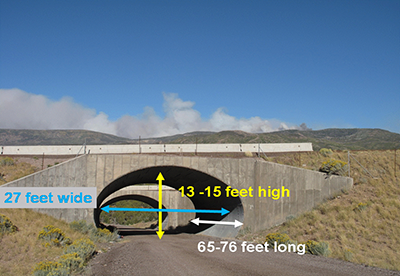|
Wildlife-vehicle collisions seriously injure or kill drivers and wildlife every day, and monetary costs associated with a single wildlife-vehicle collision can run into the tens of thousands of dollars. Additionally, roadways can contribute to habitat fragmentation, which can threaten long-term species’ health. Many transportation agencies have installed wildlife crossings and other treatments to minimize wildlife-vehicle collisions and increase habitat connectivity. Wildlife crossings are bridges, underpasses, culverts, or tunnels that provide wildlife safe access over or under a roadway. Utah went beyond simply installing wildlife crossings and used scientific research to pinpoint the most effective treatments for getting wildlife safely across roads. The State then applied the research findings to a variety of types of roads in Utah, resulting in a more effective, streamlined planning process for implementing wildlife crossings.

Mule deer use an Interstate 15 (I-15) overpass near Beaver, Utah, with fencing to guide them toward safe passage. (Courtesy of Patricia Cramer)
The Utah Department of Transportation (UDOT), Utah State University (USU), and the Utah Division of Wildlife Resources (UDWR) coordinated a comprehensive research effort, beginning in 2008, to track wildlife use of wildlife crossing structures. UDOT and UDWR have built wildlife crossings since 1975, but this was the State’s first systematic evaluation of crossings, and it is the only research of its scope in the U.S. The research identified the culvert and bridge designs that wildlife use most often to traverse major roadways in Utah. Led by USU researchers and funded by the Utah Transportation Research Advisory Council at UDOT, this study provides fresh insights for other transportation agencies to pursue similar approaches across the Nation
The Federal Highway Administration (FHWA) recognized this work with the 2013 Environmental Excellence Award for Research.
Effective Communication Leads to Remarkable Research
Collaboration between wildlife and transportation officials in Utah began in 2005 with the creation of the US 6 Wildlife Coordination Committee (Coordination Committee). Founded to mitigate wildlife impacts from roadway improvements planned along 127 miles of U.S. Highway 6 (US 6), the Coordination Committee ensured US 6 construction plans addressed major wildlife concerns, such as habitat linkage and migration route preservation.
The Coordination Committee evolved into a statewide wildlife coordination committee to encourage collaboration on other road projects, with representatives from FHWA, UDOT, USU, UDWR, the U.S. Fish and Wildlife Service, the Bureau of Land Management, and the U.S. Forest Service. Engineers and resource officials from all participating agencies evaluated their respective priorities to find common ground between economic and ecological obligations. Good communication helped Coordination Committee members understand one another’s objectives and improved streamlining so that goals stayed realistic without sacrificing safety. Encouraged and supported by this collaborative dialogue, UDOT, USU, and UDWR launched an in-depth wildlife crossing research study in 2008 to gather the necessary scientific data to better inform decisionmaking on wildlife protection in Utah. In 2010, FHWA acknowledged the Coordination Committee’s ongoing efforts with an Environmental Initiative Award.
Identifying Safe Passages for Wildlife
As part of the study, USU researchers investigated wildlife behavior using 35 remote motion-sensing cameras placed near crossings and culverts at major roadways throughout Utah. The research team recorded and analyzed movements of mule deer, elk, moose, and other large wildlife. Between 2008 and 2013, the cameras captured more than 31,000 mule deer passages through designated crossings and over a thousand animal passages via other culverts and bridges. UDWR and UDOT provided technical and research advice, checked cameras, and downloaded photos to support the effort. The study team designed the research to address the following questions:
- What crossing designs work better than others?
- How often are crossings used by different species?
- What design specifications can assist UDOT in creating the most cost-effective wildlife crossing structures that mule deer and other wildlife will use?
Answering these questions on a statewide scale helped UDOT and other agencies avoid time-consuming and costly trial-and-error processes.
Results from the Monitoring Sites
The following sites and others monitored as part of this research provided wildlife behavioral information:
US 6: Researchers monitored several bridges and culverts along a 17-mile stretch of US 6 southeast of Provo, including a recently built wildlife bridge completed in 2009. This bridge became one of the State’s most-used mule deer crossings. It is an excellent example of an effective crossing for mule deer because of its design and placement in an area humans rarely use.
Interstate 70 (I-70): Researchers collected data at 12 bridges and culverts along two segments of I-70 roughly 100 miles south of Provo. This project monitored four culverts more than 200 feet long without fencing to guide wildlife to the culvert. The cameras captured 109 mule deer at entrances, of which only 12 may have used the culverts. Few other species approached or used the culverts. These culverts accommodated access roads with an average range of 0.3 to 4.7 vehicles daily, suggesting that the high repellence rate was not due to human presence. These findings supported the hypothesis that long concrete culverts without fencing do not effectively pass wildlife.
Interstate 80 (I-80): The research also included monitoring at four locations along I-80 east of Salt Lake City. In addition to observing wildlife use of two bridged interchanges, researchers evaluated whether white lines, painted on a road to mimic cattle guards, prevent wildlife from entering the roadway. One camera mounted in spring 2010 captured 215 wildlife passes, including 95 mule deer and 115 elk. Wildlife were undeterred by paint, leading researchers to conclude that this treatment does not protect wildlife from collisions with vehicles. UDOT subsequently placed double cattle guards on the entrance and exit ramps to deter wildlife from entering the I-80 right of way.
Wide-Reaching Recommendations
This study’s recommendations are now part of Utah’s standard operation procedure for wildlife crossings. Several of the research team’s significant findings include the following:
- Bridges are the best crossing type for passing large mammals, especially elk.
- Culverts are effective when designed with wildlife in mind. The shorter a culvert, the more likely that wildlife, particularly deer, will use them. Researchers found that the maximum effective culvert length is 120 feet.
- Wildlife are sensitive to culvert length, but are less sensitive to height. Culverts can be as little as nine feet high and still pass large mammals.
- Wildlife exclusion fencing that is eight feet high effectively steers deer and other wildlife toward culverts and crossings. Only a few dozen deer might use culverts and bridges without fencing, but observations increased into the hundreds after fence installation.
- Streams through crossing structures attract all wildlife species and restore aquatic habitat connectivity. Separate walk paths must be included if streams are present to provide for crossings by hoofed animals during winter ice conditions.
- Impediments to wildlife passage include blocked entrances, rail lines through structures, recreational trails that encourage people to use the area, and noise from high-traffic areas.

This culvert under I-15 near Beaver, Utah drastically reduced wildlife-vehicle collisions. The cutaway in the middle of the road provides light, reduces the length of each culvert section, and increases the odds of wildlife passage. (Courtesy of Patricia Cramer)
Continuing the Momemtum in Utah
Wildlife monitoring research can be extremely beneficial and cost-effective for transportation agencies. In Utah, three years of wildlife monitoring cost less than two percent of the total cost of constructing a structure. In addition, the scientific data produced by this study will save the State money in the long run by streamlining efforts to make roads safer and protect wildlife. The valuable findings from the research outlined here show that collaboration is essential for large-scale wildlife studies.
To build off of the cooperative environment in Utah and the success of this research, UDOT committed $250,000 to a five-year monitoring program on U.S. Highway 89 between Southern Utah and Northern Arizona, an area with a large migrating mule deer herd. The Arizona Game and Fish Department and UDOT will monitor seven crossings with five different opening sizes. Researchers will assess these crossings for effectiveness in passing wildlife and will tailor their study methods based on the project detailed here. This will be the first interstate collaboration to monitor wildlife crossings. UDOT expects that combining the expertise of Arizona and Utah will multiply the research benefits, and that the information garnered from this work will be valuable for further streamlining the process for planning wildlife crossings throughout the Western United States.
Contact Information
Patricia Cramer, Ph.D.
Research Assistant Professor
Department of Wildland Resources
Utah State University
(435) 764-1995
patricia.cramer@usu.edu
Monte Aldridge, P.E.
Preconstruction Engineer
Utah Department of Transportation
Region 4
(435) 893-4738
maldridge@utah.gov
Randall Taylor
Environmental Engineer
Utah Department of Transportation
Region 4
(435) 893-4714
randalltaylor@utah.gov
Bill Ostrum
Office of Project Development and Environmental Review
Federal Highway Administration
(202) 366-4651
william.f.ostrum@dot.gov
Look What’s New!
- The Eco-Logical Webinar Series will present a webinar on January 8th about environmental programmatic agreements and consultations, Step 7 of the Integrated Ecological Framework. The Integrated Ecological Framework is a tool designed to help transportation and resource agencies work together to integrate transportation and ecological decision making. The webinar is from 2PM to 3PM ET.
|

